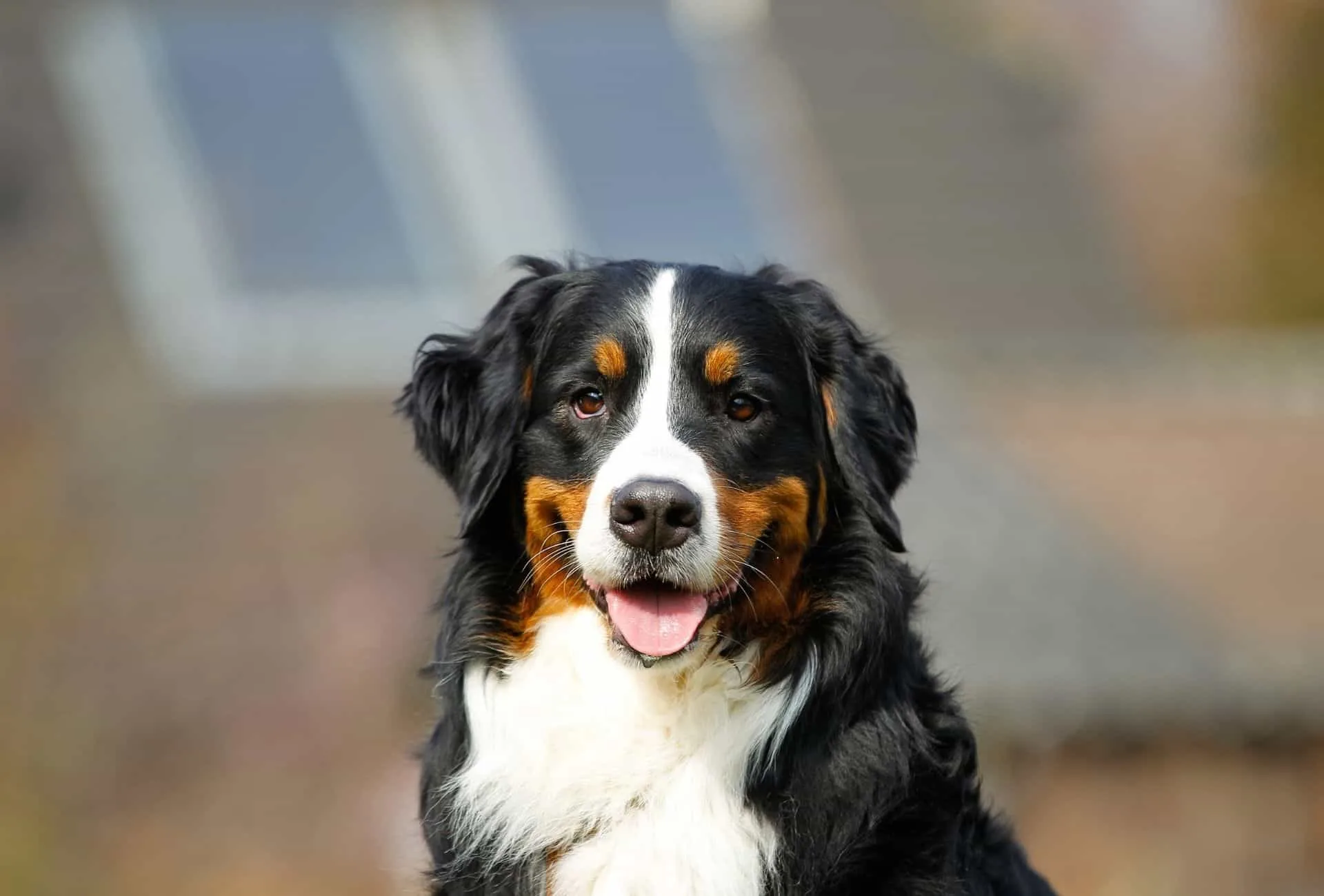Bernese Mountain Dogs are one of nature’s greatest creations.
These gorgeous beings are tough, large, and huggable giants uniquely marked with a compelling mixture of colors.
No wonder the plush-toy industry benefits from their appearance so much.
Apart from that, did you know that the FCI actually has a category called: “Pinscher and Schnauzer – Molossoid and Swiss Mountain and Cattledogs”.
Despite their special standing in the breed classification, they’re actually kind of Molossoid dogs too.
Once brought to Europe by the Romans as Molosser dogs, the breed evolved to what we call the Bernese Mountain Dog nowadays.
They are working farm dogs originating from the canton Bern in Switzerland.
Except for protecting and leading cattle herds, BMD’s were also used for pulling milk carts from one market to another.
Bernese Mountain Dogs mature slowly and never lose that cute puppy behavior.
Besides the mellow aspects of cuddling, it also means a high energy level that can tire the owner out.
The goofy and seemingly immature personality in no way affects their strong intelligence and loyalty.
BMD’s are watchful and vigilant and won’t let anyone harm their family or herd in any way.
One of the few breeds that are recommended for babysitting is BMD, although, you might want to think twice about hiring a dog as a babysitter.
Their super-soft paws are so big that you can use them as cushions and they won’t mind it at all. This breed is gentle with other dogs as well.
The thing that concerns most owners and adorers of Bernese Mountain Dogs is their relatively short life expectancy of 8.4 years according to the study by the Swiss Federal Food Safety and Veterinary Office.
Compared to other breeds of similar size their lifespan is shorter by about 3-4 years.
As dog owners, our goal is to be able to live as long as possible with our dogs and make their comparatively short life most enjoyable.
To help you achieve that, we have compiled everything you need to know about breed-related health issues and what you can do to increase your Bernese’s lifespan.
What Health Problems do Bernese Mountain Dogs Have?
There is a handful of diseases that commonly affect Bernese Mountain Dogs.
Major health issues of the Bernese Mountain dog are common for large breeds like hip or elbow dysplasia while some types of cancers they are prone to must be taken very seriously.
Less frequent health issues include Von Willebrand’s Disease.
More on all that below.

Hip Dysplasia
Hip dysplasia is a hereditary disorder in Bernese Mountain Dogs.
It’s advised that dogs with severe symptoms of hip dysplasia do not have offsprings.
Hip dysplasia is one of the most common musculoskeletal disorders in large breed dogs.
Due to the fast growth of the dog’s bones and the overall body development the head (upmost portion) of the femur bones doesn’t fill the hip socket.
That makes the joint fragile.
In time the structures in the joint become inflamed (arthritis) and thus the first signs of hip dysplasia appear.
There is no telling for sure when exactly a Bernese Mountain Dog with hip dysplasia will present one of the following symptoms:
- Lameness
- Stiff hind legs
- Bunny hopping while running
- Pain during exercise
- Difficulty getting up
- Atrophic hind-legs muscles
Puppies with severe dysplasia will start limping anywhere between 6 months and 12 months of age.
Mild cases can go unnoticed throughout the entire life of the dog.
The severity will also determine how the condition will be treated and unfortunately, a surgical approach is often necessary.
When buying a puppy, always make sure to get a health-tested Bernese to drastically reduce these risks.
Elbow Dysplasia
Similar to the hip problem, elbow dysplasia is another hereditary condition in Bernese Mountain Dogs as well as other fluffy giants.
The dog’s elbows develop abnormally resulting in degenerated and malformed joints.
Usually, the dogs are presented with initial signs starting from 4 months up to 10 months of age.
Symptoms of elbow dysplasia in dogs include:
- Lameness (persistent or occasional)
- Expressed lameness after exercise
- Discomfort when extending the elbow
- Keeping the affected limb away from the body
- Narrowed range of motion of the joint
- Build of fluid in the area
Most cases of elbow dysplasia are surgically managed, although we ideally don’t want to get to that point.
Since both types of dysplasia are present during the dog’s juvenile period, owners of Bernese Mountain Dogs are advised to take x-rays of their pup’s legs at 6 months of age.
That being said, x-rays are only fully conclusive after the bone growth is finished at the age of around 2 years.
There’s no direct way to prevent these issues but responsible breeding, proper exercise, and a healthy diet all contribute to the dog’s overall health.
Progressive Retinal Atrophy
Yet another inherited condition in BMD’s is degeneration of the retina of the eye.
The retina is the back portion of the eye where the photoreceptors are located – the cells responsible for converting the light into electrical signals sent to the brain.
These cells start deteriorating over time and unfortunately, the dog becomes completely blind.
One form of the disease develops in puppies around 3 months of age, while the other happens later in life (3-8 years of age).
The first symptom of progressive retinal atrophy in dogs is night blindness.
Afterward, the owners notice constantly dilated pupils and disorientation at places outside the home.
There is no known trigger or cure for PRA in dogs.
If you got your dog from a breeder ask for a health certificate as a guarantee that your pup’s parents didn’t have it.
DNA tests for detecting PRA are available when you want to be 100 % sure your Berner is healthy.
Von Willebrand’s Disease
Many times veterinarians start suspecting a dog of having vWD only when the patient is undergoing surgery and can’t stop bleeding.
Even minor cuts result in excessive bleeding.
Symptoms of the condition include:
- Bleeding from the nose or mouth
- Dark stool (bleeding from the GI tract)
- Blood in urine
- Excessive bleeding
- Anemia
Von Willebrand’s Disease in dogs is hereditary and there’s no completely effective treatment known yet.
Luckily, you can avoid this when choosing a pup with DNA testing.

Cancer (Histiocytosis)
The most frequent cause of death in Bernese Mountain Dogs is cancer (almost 60% of cases).
Of all cases of cancer within the breed, histiocytosis comprises a staggering 25%.
Not only is this type of cancer common in BMD’s, but it’s also extremely rare in other types of breeds.
Histiocytes are a type of white blood cells.
When they turn cancerous they reproduce extremely fast and invade different tissues in the body.
The malignant form of the cancer is especially aggressive and once it starts it ends fatally in a matter of weeks.
The systemic form comes and goes in episodes, but leads to death eventually.
The most common symptoms are:
- Anorexia
- Lethargy
- Anemia
- Progressive weight loss
- Skin abnormalities (only with systemic form)
Although chemotherapy can prolong your dog’s life, there is no effective treatment for histiocytosis.
Gastric Volvulus (Torsion)
Torsion of the stomach is an emergency life-threatening situation when the entrance and the exit of the organ are partially or completely shut.
This causes the stomach to expand because of gas or fluid build-up.
When the torsion cuts the blood circulation some tissues of the stomach start dying.
The situation can turn from bad to worse in a matter of minutes so if you suspect gastric torsion you need to take your dog to the ER fast.
The most common symptoms are:
- Distended abdomen
- Vomiting
- Coughing
- Drooling
- Pale Gums
The first course of treatment is to deflate the stomach and release the excess gas.
This is achieved while the dog is sedated and a tube is passed down to the inside or the organ.
If there is a complete blockage an emergency surgery has to be performed to deflate and reposition the stomach while stapling it in place to prevent such events from recurring.
What do Bernese Mountain Dogs Usually Die From?
Bernese Mountain Dogs mostly die from cancer (58.3%), according to a Swiss study.
Less commonly the reason for death is a degenerative joint disease (4.2%), spinal disorders (3.4%), and kidney insufficiency (3.1%).
In less than 2% of cases, the cause of death is gastric volvulus.
Not all cancers in BMD’s are malignant histiocytosis. Other less frequent types include:
- Hemangiosarcomas
- Mast cell tumors
- Malignant melanomas
- Lymphomas and lymphosarcomas
- Osteosarcomas
Heart Diseases, Allergies, Hypothyroidism, and Epilepsy have all been reported in Bernese Mountain Dogs of all ages.
What is the Longest Living Bernese Mountain Dog?
It’s not all bad news regarding Bernese’s life expectancy.
Verena Wulf in Germany was the proud owner of a Bernese Mountain Dog who lived 25 years.
The dog’s name was Penny and she is probably the longest living representative of the breed.
How to Extend Your Dog’s Lifespan?
Gather information about your dog’s parents.
Even though this can’t change your dog’s life expectancy it could give you a clearer picture of what to expect in the future.
Most diseases in BMD’s are inherited so it’s good to know your dog’s chances.
However, there are some things you can do to extend your dog’s individual lifespan or at the very least, quality.
A preventative measure is keeping your dog fit and slim around the waistline. Lean dogs of all breeds live a bit longer (1-2 years) than the chubby ones.
Overweight puppies can experience a lot worse symptoms of hip dysplasia compared to their fit counterparts.
There isn’t enough information on dogs living in homes to support the theory.
However, an association between life expectancy and body condition was made by gathering data from 900 veterinary establishments in North America that supported it.
Other factors to extend your Bernese Mountain Dog’s lifespan are the right kind of exercise, diet, and keeping your dog fit mentally.
Here are a couple of tips fo easily avoidable conditions like gastric torsion in dogs:
Never let your dog be physically active one hour before and after a full meal.
Give smaller portions throughout the whole day and don’t use an elevated food bowl.
Use high-quality food easy to digest.
Bernese Mountain Dogs have such a short lifespan because of inherited disorders.
In Switzerland, there are government regulations that forbid breeding dogs carrying such disorders, but in other countries barely any regulations exist.
DNA testing should be encouraged to detect gene malformations.
Promoting healthy pups can help extend the short lifespan of Bernese Mountain Dogs.
Disclaimer: This blog post does not substitute veterinary attention and does not intend to do so. I am not a veterinarian or pet nutritionist. If your dog shows any sign of illness, call your vet.